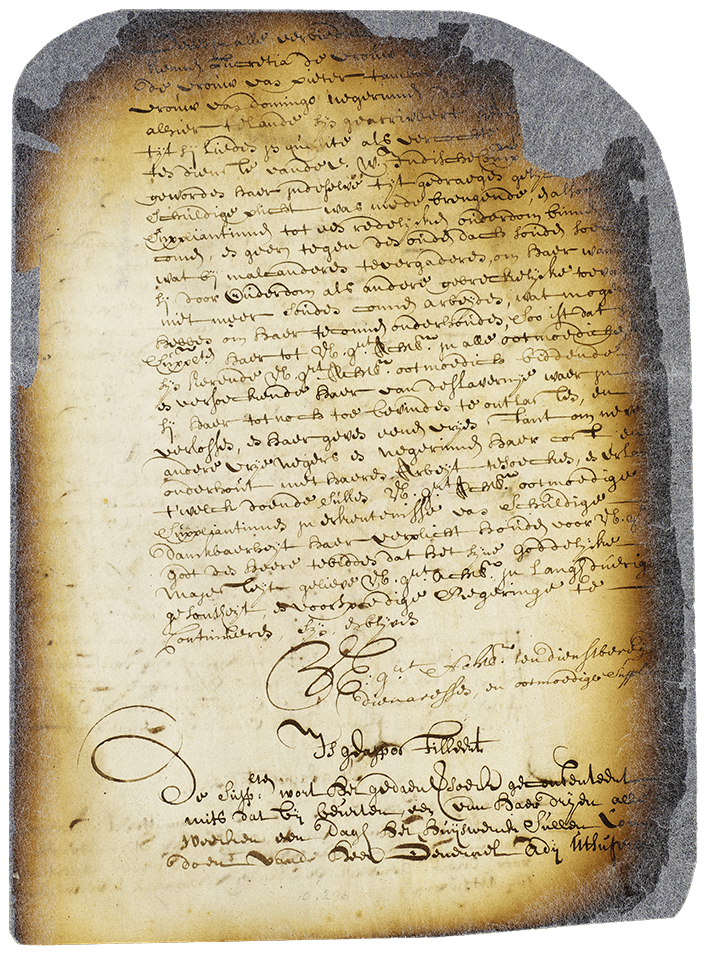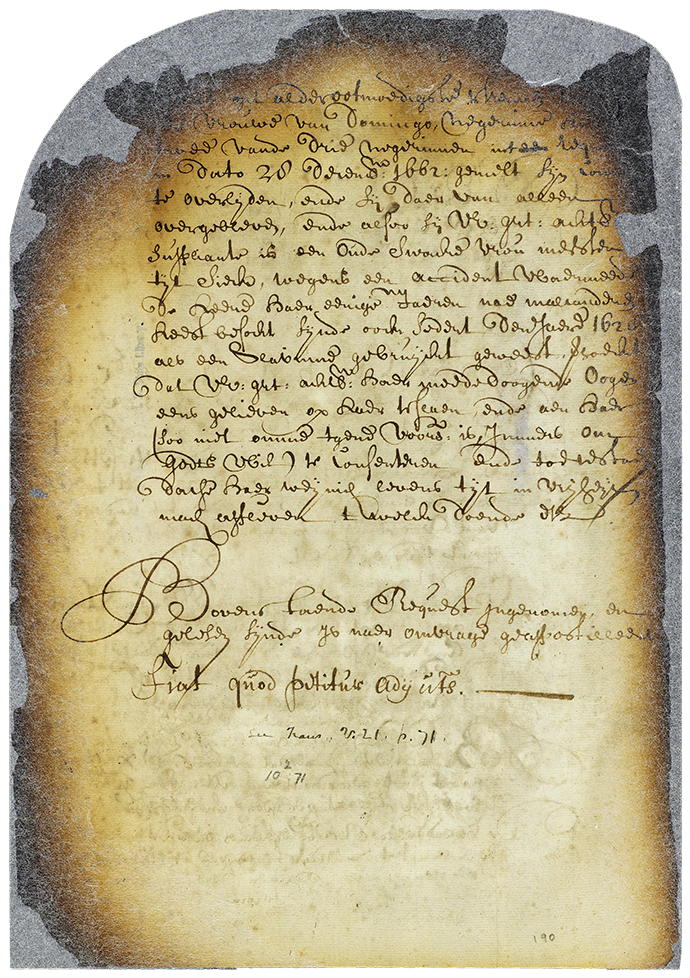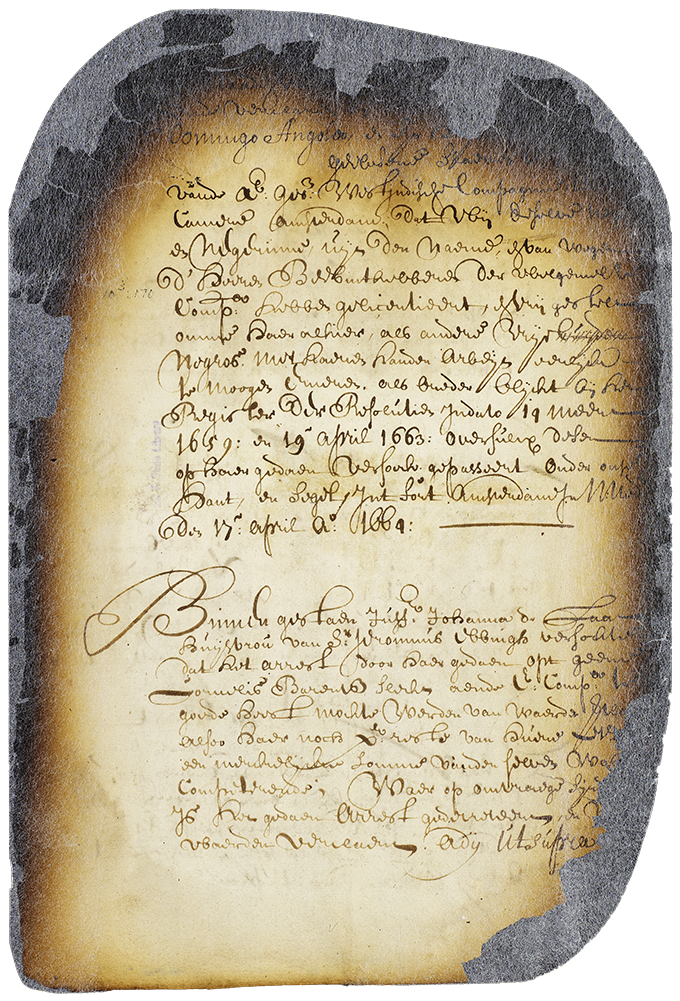Document Text |
Summary |
| Mayken Van Angola, Lucretia Albiecke van Angola, and the wife of Peter Tamboer all humbly request the government to release us from slavery so we can be together in our old age and earn our income with our work along with other free blacks . . . | Mayken Van Angola and two of her friends ask the government to grant them freedom so that they can take care of one another in their old age. |
| The supplicants’ request is approved provided that they take turns doing the housework of the Lord General Peter Stuyvesant one day every week. | The government approves their request as long as they agree to take turns cleaning the house of Director Peter Stuyvesant. |
Petition, December 28, 1662. New York State Archives. Translation by Eric Ruijssenaars.
Document Text |
Summary |
| As two of the three women from the petition dated December 28, 1662 have died, and because she is an old, weak woman who has been a slave since the year 1628 and suffers from an injury from a long ago accident, Mayken van Angola requests that the government take pity on her and allow her to live the rest of her remaining time in freedom with the other free blacks of New Amsterdam . . . | Mayken makes a second request for freedom because her two friends have died. She also reminds the government that she has been enslaved since 1628, and tells it that she suffers pain from an old injury. |
Petition, April 19, 1663. New York State Archives. Translation by Eric Ruijssenaars.
Document Text |
Summary |
| In the name of and on behalf of the lords Directors of the Dutch West India Company, we permit the negress Mayken to be made free so that she can make her living in an honest way like any free black person . . . | The government finally agrees to set Mayken free without any conditions. |
Certificate, April 17, 1664. New York State Archives. Translation by Eric Ruijssenaars.
Background
The Dutch government had no clearly established laws governing slavery in the 1600s. In the colony of New Netherland enslaved people could marry, attend religious services, receive payment for their work, and petition the government. In 1644 the first enslaved people in New Netherland used their rights to petition for their freedom. Many of these petitions were approved, but there were often limits to the freedom that enslaved people were granted by the Dutch West India Company.
About the Document
These three documents chronicle Mayken van Angola’s two-year quest for freedom. Mayken had been enslaved by the Dutch West India Company for thirty-four years when she submitted this petition in 1662. These documents show how enslaved people of New Netherland understood the law and their legal options. They also demonstrate that enslaved people could skillfully navigate challenges on their road to freedom.
Vocabulary
- Dutch West India Company: The company that owned and ran New Netherland.
- New Netherland: The Dutch colony in North America, which encompassed land between the Connecticut and Delaware Rivers, and up the Hudson River to present-day Albany, New York.
- petition: A written request submitted to a powerful person or the government.
Discussion Questions
- What reasons does Mayken van Angola give for needing her freedom? What does this reveal about the attitude of the Dutch West India Company toward enslaved people?
- What is the first condition of Mayken van Angola’s freedom? Why do you think the Dutch West India Company put in this condition? Why does she submit another petition only four months after the first one?
- Mayken van Angola arrived in 1628, four years after the Dutch established the colony. What does Mayken van Angola’s story teach us about the experience of enslaved people in the Dutch colonies?
Suggested Activities
- APUSH Connection: 2.7 Colonial Society and Culture
- Include this resource in a lesson about slavery and abolition. This document shows that enslaved people have actively pursued self-emancipation through a variety of means since the colonial era.
- Compare and contrast Mayken van Angola’s petitions for freedom with Life Story: Dorothy van Angola. Why are the experiences so different? What does this tell us about the Dutch laws governing slavery?
- Combine this document with the Life Story: Lisbeth Anthonijsen to create a lesson about the attitudes of the Dutch colonial authorities toward Black women in their colony.
- Mayken van Angola’s name means she was from the African region of Angola, and probably endured the Middle Passage before she ended up in New Netherland. Combine this document with the The Middle Passage for a more complete picture of Mayken van Angola’s life as an enslaved woman.
- Compare Mayken van Angola’s quest for freedom with Life Story: Marie-Josèphe Angélique and Life Story: Juana, la Virreina de Matudere. Why did these women try different approaches to gaining their freedom? What do their stories reveal about the lives of enslaved women in their respective colonies?
- For a larger lesson on abolition and manumission through petitions, combine this resource with the following:
Themes
POWER AND POLITICS









